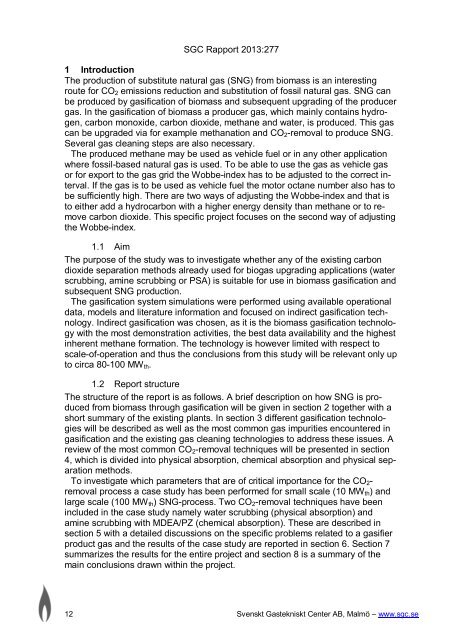Carbon dioxide removal in indirect gasification - SGC
Carbon dioxide removal in indirect gasification - SGC
Carbon dioxide removal in indirect gasification - SGC
You also want an ePaper? Increase the reach of your titles
YUMPU automatically turns print PDFs into web optimized ePapers that Google loves.
<strong>SGC</strong> Rapport 2013:277<br />
1 Introduction<br />
The production of substitute natural gas (SNG) from biomass is an <strong>in</strong>terest<strong>in</strong>g<br />
route for CO2 emissions reduction and substitution of fossil natural gas. SNG can<br />
be produced by <strong>gasification</strong> of biomass and subsequent upgrad<strong>in</strong>g of the producer<br />
gas. In the <strong>gasification</strong> of biomass a producer gas, which ma<strong>in</strong>ly conta<strong>in</strong>s hydrogen,<br />
carbon monoxide, carbon <strong>dioxide</strong>, methane and water, is produced. This gas<br />
can be upgraded via for example methanation and CO2-<strong>removal</strong> to produce SNG.<br />
Several gas clean<strong>in</strong>g steps are also necessary.<br />
The produced methane may be used as vehicle fuel or <strong>in</strong> any other application<br />
where fossil-based natural gas is used. To be able to use the gas as vehicle gas<br />
or for export to the gas grid the Wobbe-<strong>in</strong>dex has to be adjusted to the correct <strong>in</strong>terval.<br />
If the gas is to be used as vehicle fuel the motor octane number also has to<br />
be sufficiently high. There are two ways of adjust<strong>in</strong>g the Wobbe-<strong>in</strong>dex and that is<br />
to either add a hydrocarbon with a higher energy density than methane or to remove<br />
carbon <strong>dioxide</strong>. This specific project focuses on the second way of adjust<strong>in</strong>g<br />
the Wobbe-<strong>in</strong>dex.<br />
1.1 Aim<br />
The purpose of the study was to <strong>in</strong>vestigate whether any of the exist<strong>in</strong>g carbon<br />
<strong>dioxide</strong> separation methods already used for biogas upgrad<strong>in</strong>g applications (water<br />
scrubb<strong>in</strong>g, am<strong>in</strong>e scrubb<strong>in</strong>g or PSA) is suitable for use <strong>in</strong> biomass <strong>gasification</strong> and<br />
subsequent SNG production.<br />
The <strong>gasification</strong> system simulations were performed us<strong>in</strong>g available operational<br />
data, models and literature <strong>in</strong>formation and focused on <strong>in</strong>direct <strong>gasification</strong> technology.<br />
Indirect <strong>gasification</strong> was chosen, as it is the biomass <strong>gasification</strong> technology<br />
with the most demonstration activities, the best data availability and the highest<br />
<strong>in</strong>herent methane formation. The technology is however limited with respect to<br />
scale-of-operation and thus the conclusions from this study will be relevant only up<br />
to circa 80-100 MWth.<br />
1.2 Report structure<br />
The structure of the report is as follows. A brief description on how SNG is produced<br />
from biomass through <strong>gasification</strong> will be given <strong>in</strong> section 2 together with a<br />
short summary of the exist<strong>in</strong>g plants. In section 3 different <strong>gasification</strong> technologies<br />
will be described as well as the most common gas impurities encountered <strong>in</strong><br />
<strong>gasification</strong> and the exist<strong>in</strong>g gas clean<strong>in</strong>g technologies to address these issues. A<br />
review of the most common CO2-<strong>removal</strong> techniques will be presented <strong>in</strong> section<br />
4, which is divided <strong>in</strong>to physical absorption, chemical absorption and physical separation<br />
methods.<br />
To <strong>in</strong>vestigate which parameters that are of critical importance for the CO2<strong>removal</strong><br />
process a case study has been performed for small scale (10 MWth) and<br />
large scale (100 MWth) SNG-process. Two CO2-<strong>removal</strong> techniques have been<br />
<strong>in</strong>cluded <strong>in</strong> the case study namely water scrubb<strong>in</strong>g (physical absorption) and<br />
am<strong>in</strong>e scrubb<strong>in</strong>g with MDEA/PZ (chemical absorption). These are described <strong>in</strong><br />
section 5 with a detailed discussions on the specific problems related to a gasifier<br />
product gas and the results of the case study are reported <strong>in</strong> section 6. Section 7<br />
summarizes the results for the entire project and section 8 is a summary of the<br />
ma<strong>in</strong> conclusions drawn with<strong>in</strong> the project.<br />
12 Svenskt Gastekniskt Center AB, Malmö – www.sgc.se

















